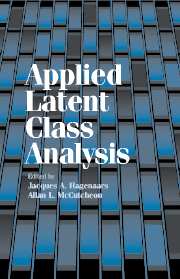Book contents
- Frontmatter
- Contents
- Contributors
- Preface
- INTRODUCTION
- CLASSIFICATION AND MEASUREMENT
- CAUSAL ANALYSIS AND DYNAMIC MODELS
- 8 Use of Categorical and Continuous Covariates in Latent Class Analysis
- 9 Directed Loglinear Modeling with Latent Variables: Causal Models for Categorical Data with Nonsystematic and Systematic Measurement Errors
- 10 Latent Class Models for Longitudinal Data
- 11 Latent Markov Chains
- UNOBSERVED HETEROGENEITY AND NONRESPONSE
- Appendix A: Notational Conventions
- Appendix B: Further Readings
- Appendix C: Selected Software; Webpage
- Index
11 - Latent Markov Chains
Published online by Cambridge University Press: 31 July 2009
- Frontmatter
- Contents
- Contributors
- Preface
- INTRODUCTION
- CLASSIFICATION AND MEASUREMENT
- CAUSAL ANALYSIS AND DYNAMIC MODELS
- 8 Use of Categorical and Continuous Covariates in Latent Class Analysis
- 9 Directed Loglinear Modeling with Latent Variables: Causal Models for Categorical Data with Nonsystematic and Systematic Measurement Errors
- 10 Latent Class Models for Longitudinal Data
- 11 Latent Markov Chains
- UNOBSERVED HETEROGENEITY AND NONRESPONSE
- Appendix A: Notational Conventions
- Appendix B: Further Readings
- Appendix C: Selected Software; Webpage
- Index
Summary
INTRODUCTION
This chapter deals with longitudinal categorical data. Such data may be of two types, in general. Type I refers to the situation in which a few subjects are measured repeatedly at many occasions. The models and methods relevant in this case are those of time series analysis. Type II refers to the reverse situation in which many subjects are measured repeatedly at a few (typically three to five) occasions, resulting in so-called panel data. If such data are categorical, one approach of analysis is by means of Markov chain models. These are the kind of models this chapter focuses on.
The goal then is to make statements about what happens from one point in time to the next, for example, whether consumers stay with a given brand (are brand loyal) or switch to some other brand. Apart from consumer behavior, Markov chain models have been applied in many other settings, such as attitude change; income, geographic, and industrial labor mobility; interpersonal relationships; voting behavior; animal behavior; learning; cognitive development; meteorology; and epidemiology.
It seems to be unanimous that the term Markov chain refers to discrete variables (i.e., categorical variables, items, or, more generally, indicators with response categories such as Yes/No; Agree/Disagree; Pass/Fail; Employed/Unemployed/Not in the labor force; Democrat/Republican/Don't Know) measured repeatedly over time with the same sample of subjects (panel data) and that the dynamics across time are modeled by assuming a discrete time process in order to make statements about change, stability, or both.
- Type
- Chapter
- Information
- Applied Latent Class Analysis , pp. 304 - 342Publisher: Cambridge University PressPrint publication year: 2002
- 34
- Cited by



